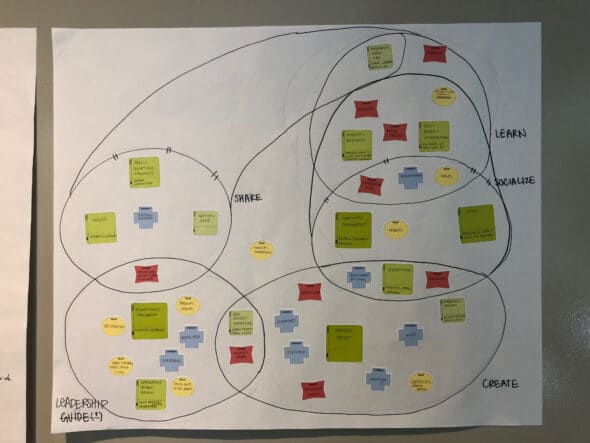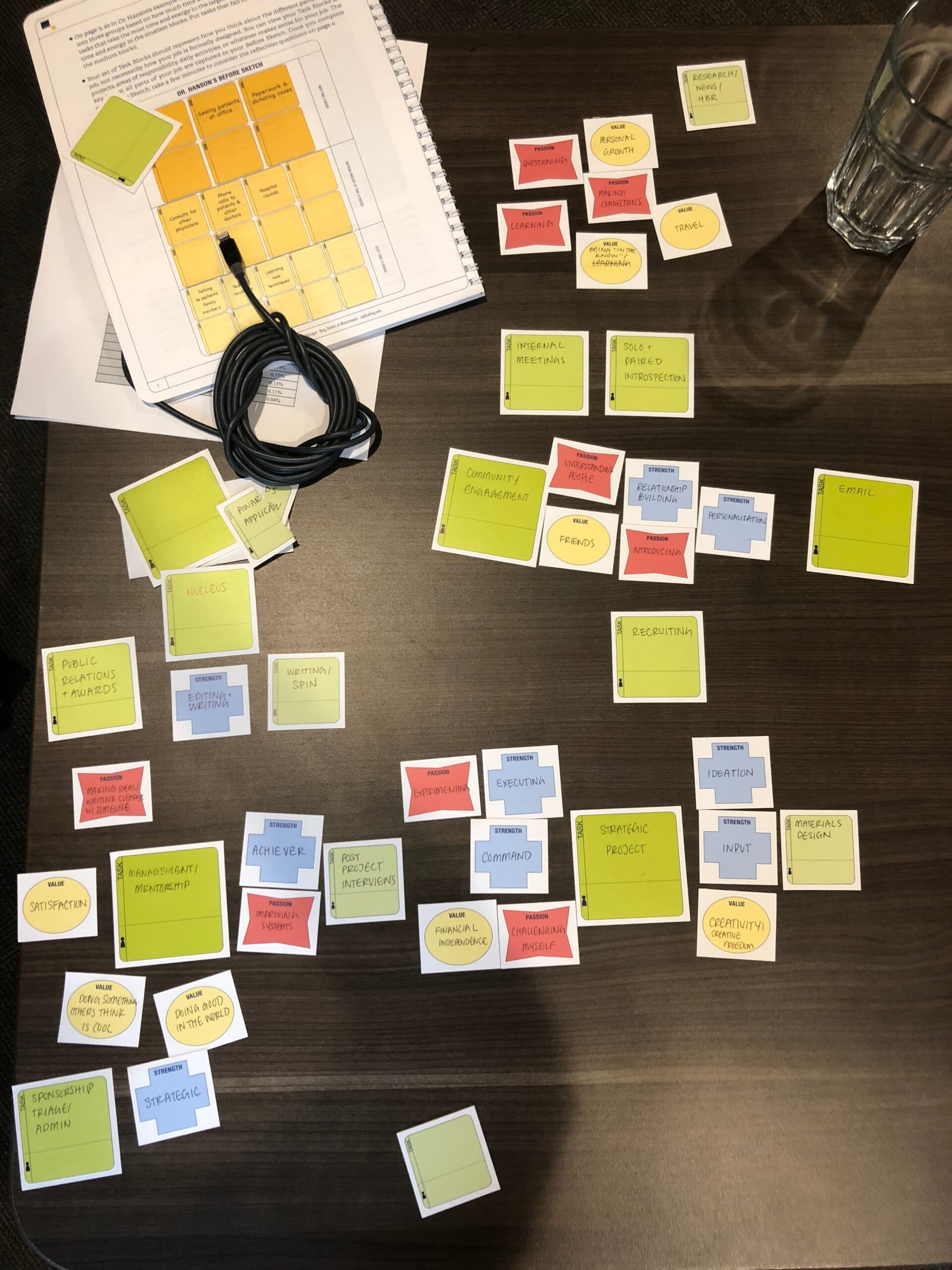Covid-19 brought with it a slew of headlines about reactionary trends. First, there was no toilet paper. Then we needed to wipe down our cereal boxes. We swore off jeans. Now, we’re leaving our jobs — those of us who have them, at least. The media clamped onto these stories until they edged into reality. Pretty soon, we were making a run on Costco’s Quilted Northern supply and pondering whether we, too, should dust off the old resume. If you’ve been dreaming of a new gig for years, it probably is time to split. But if you’re feeling a little fear of missing out—a sense that work could be about 15 percent better, try an exercise in Job Crafting first.
What is Job Crafting?
Job Crafting is the process of bringing together the requirements of a job and the complex humanity of the person who fills it.
Researchers Justin M. Berg, Jane E. Dutton, and Amy Wrzesniewski developed the model in the late aughts (right here in Ann Arbor!). They argue employees who redesign their roles are more fulfilled at work.
See, we design jobs backward. Managers write job descriptions in the abstract — without the actual employee in mind. But, Job Crafting turns this pattern on its head. The practice starts with the employee’s values, strengths, and passions and crafts that employee’s responsibilities around them.
A simple example: imagine someone serving as a receptionist at a gym. The gym’s goal for this role is to deliver a top-notch service experience to new clients. The receptionist could craft his job depending on his personality, interests, and skills.
If the receptionist was funny, he could disarm attendees with some self-effacing jokes as they tour the facility. If the receptionist was into data, he could analyze new client sign-ups and coordinate giveaways during those times.
You get the idea. The trick is to engage the receptionist himself in the way he does his job so that the role can draw on his natural preferences and abilities. This makes the receptionist happier and his work more effective.
Could it cure your FOMO?
Who hasn’t seen photos of lavish offices, zany perks, or exotic business travel on LinkedIn and started to dream about what might be?
As with other social media, LinkedIn bragging shows a partial truth. We all know there are great parts and cruddy parts at any job, and we’re more likely to post the great ones. The siren song of the LinkedIn post might excite you about a new opportunity. But the thing about FOMO is that you never actually cure it by chasing the fear. The harder part is figuring out what you want; it might already exist — invisible to you — in the job you have.
In my experience, work perks, compensation, or even titles don’t drive professional fulfillment. More impactful are autonomy, mastery, purpose, and relationships. Job Crafting is the best tool to measure and imagine these aspects of a job from what I’ve seen.
(Let me be clear: You need to be able to take care of yourself and those who rely on you. In addition, you need a workplace free from abuse and harassment. You need to make sure you’re getting your basic human needs met. These are all great reasons to seek a greener pasture. I’m addressing the folks who are just feeling antsy after a year of languishing.)
Trying out an exercise in Job Crafting can be a good test of the roots of your FOMO. Once you do, you’ll have a better sense of whether your discontent was due to an addressable poor fit, or a fundamental poor fit.
How Does Job Crafting Work?
Every manager should lead their reports through Job Crafting. This shows that managers support the professional development of their employees. Having a manager there helps the employee see where the organizational constraints on the job crafting exist. Job Crafting also has some studied benefits for organizations, if that helps get your manager on board.
That said, employees can try job crafting on their own and find great value in it. The first time I tried Job Crafting alone, I realized I wanted to try to take on a managerial role.
You can buy Job Crafting activity booklets and even an online assessment tool. I recommend investing in these — in particular the booklet (it has stickers!). But I’ll offer a general outline of the practice below:
First, you break down the existing structure of your job. This includes reflecting on the activities you invest your time and energy into. You’re prompted to reflect on the most energizing and draining aspects of your job.
Then, you brainstorm the three aspects that represent you—your:
- Values: What do you want to see out of your work?
- Strengths: What are your natural talents?
- Passions: What motivates you?
Then comes the fun part: clustering your job responsibilities with your values, strengths, and passions. You’ll find some of your responsibilities are well-suited to your unique motivators and preferences. Others will stick out as odd ducks. When you perceive the ill-fitting aspects of your job, Job Crafting equips initiates with three methods of redesigning your job:
- Tasks (adding, changing, subtracting the activities that comprise their work);
- Relationships (whom you work with or interface with to get work done); and
- Perception (how you frame the purpose behind an existing task or relationship)
These changes get expressed by creating a visual map that connects your responsibilities at work to your strengths, values, and passions wherever they intersect (or don’t). In the end it looks kinda like this:

Job Crafting often sparks important mental shifts.
When you finish the exercise, the result might be a little messy, but it should spark some realizations.
I realized some work used to fill my learning bucket but no longer did; I was ready to teach someone else how to do those tasks. I also realized that my assumption that I either needed to be someone who created things at work or someone who managed people was a false dichotomy. These insights helped me see how I could use the responsibilities I had then to sharpen the skills I wanted. And eventually, this exercise helped me see the path I wanted to be on, and it helped me shape a new role for myself that was new to the organization.
Without these takeaways, I may well have let my assumptions send me on a job hunt. I’d have missed out on the empowering and fulfilling work I’ve done with my managers to craft a career that works for me.
Finding a fresh start without throwing in the towel.
I’ve done job crafting personally twice and led the marketing team in it twice. I wouldn’t say it ever radically upended my job, but it always improved my relationship with it. Having crafted my job, I felt like I had a calmer sense of what I was doing and why I was doing it. I also felt as though I had a new lens through which to view the purpose behind less attractive aspects of my job. And if there was no purpose to those aspects, I had more agency to identify that after Job Crafting so that I could start to wean that obligation away.
Now that we’re all in a state of reconciling our present to our past professionally, it’s a great time to think about the sort of job we want. For many people, that might mean finding work in a new company. For others, that might be finding a new purpose in an old job. No matter which path you’re on, Job Crafting can get you closer to finding the role that fits.

